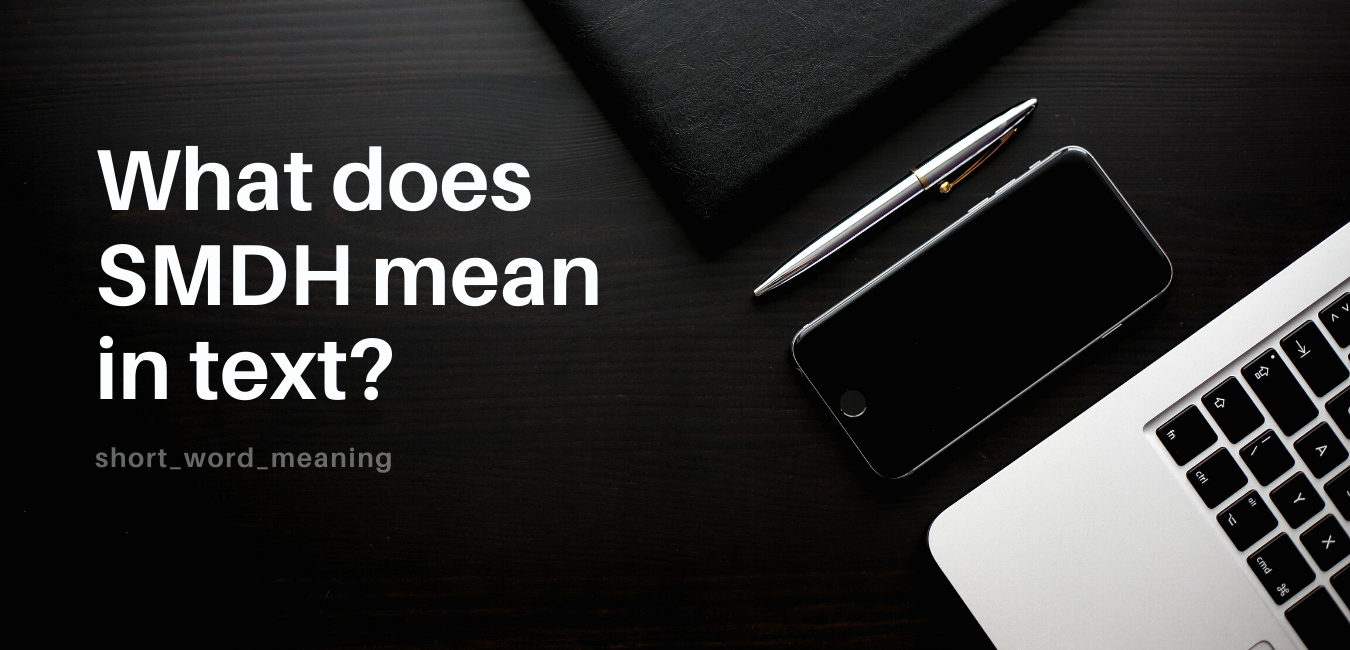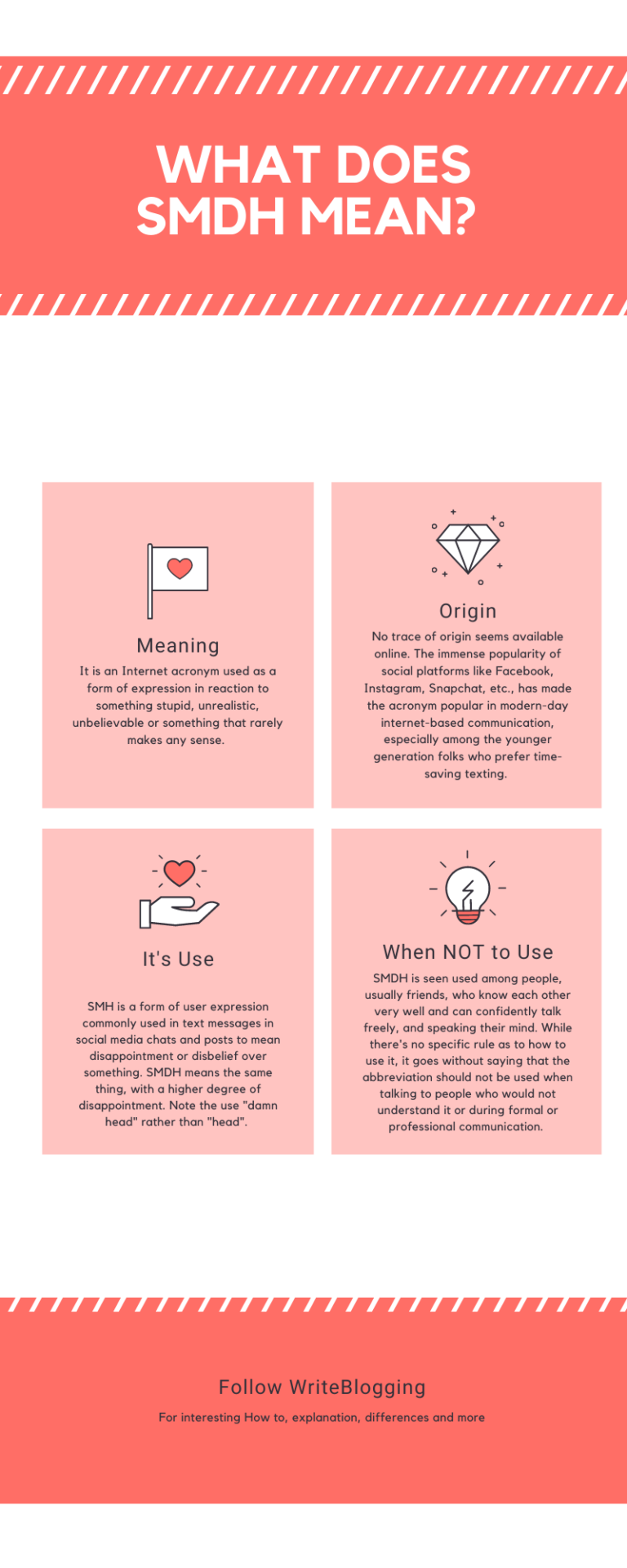Smdh Meaning: Shaking My Damn Head Explained | Texting Slang
Ever scrolled through your social media feed and encountered a string of letters that left you scratching your head? The digital age has spawned a lexicon of acronyms and abbreviations, and one of the most prevalent is "smdh."
Often punctuating the end of a text message or gracing a comment on a viral video, "smdh" has become a ubiquitous expression of disbelief, frustration, or disappointment. This seemingly simple string of characters encapsulates a world of sentiment, communicating complex emotions with remarkable efficiency. While it may seem like a modern phenomenon, its roots lie in the evolution of online communication and the ever-present need for concise expression. Its usage has exploded along with the proliferation of text messaging and social media platforms like Twitter, Instagram, Facebook, Snapchat, and TikTok, where brevity is often prized and nuance can be tricky to convey.
So, what exactly does "smdh" stand for? It's a shortened form of the phrase "shaking my damn head." The "damn" serves as an intensifier, adding a layer of emphasis to the expression. The phrase itself reflects a physical action, a gesture of exasperation or incredulity that has been translated into the digital realm. The user is essentially communicating that they are so overwhelmed by a situation, a comment, or an action that the only appropriate response is a head shake.
The origins of "smdh" can be traced back to the early 2000s with the rise of text messaging and social media. These platforms provided a space for the evolution of language, where new forms of expression rapidly emerged. As users sought ways to communicate more quickly and efficiently, abbreviations and acronyms like "smdh" flourished. The term quickly spread through online communities, becoming a shorthand for expressing a shared sense of bewilderment or disapproval. While the original term "smh," which stands for "shaking my head," was already in widespread use, "smdh" offered an even more emphatic way to express the sentiment. The addition of "damn" underscores a greater level of frustration, indicating a stronger reaction.
The usage of "smdh" is versatile, lending itself to a variety of contexts. It can be used to react to a friend's unfortunate mishap, a politician's controversial statement, or even a particularly outlandish fashion choice. For instance, if a friend sends a text message detailing an embarrassing encounter, a user might respond with "smdh." Similarly, in response to a news story about government corruption, a user might post, "smdh." The terms adaptable nature makes it a powerful tool for conveying a range of emotions across different social media platforms.
The meaning of "smdh" can vary slightly depending on the context and the individual using it. Primarily, it conveys disappointment, frustration, or disbelief. It suggests that the user finds the situation or statement to be foolish, shocking, or hard to believe. The "damn" amplifies the feeling, indicating a deeper level of emotion compared to a simple "smh." The term is rarely used in formal settings, but it's become an integral part of online communication, especially among younger generations who are adept at using and interpreting slang.
The evolution of "smdh" exemplifies how language adapts and evolves to fit the needs of its users. The expression has become a staple in the digital vernacular, serving as a quick, efficient, and widely understood way to convey a complex range of emotions in a concise manner.
In the world of texting and social media, efficiency is key. "Smdh" is just one example of how users have adapted language to save time and communicate effectively. Much like other acronyms such as "lol," "brb," and "imo," "smdh" is a time-saver, allowing individuals to express complex feelings without typing out full phrases.
The use of abbreviations is not limited to online communication. They are often incorporated grammatically into the text. For instance, someone might write "I'm smh because of his antics." This demonstrates how the acronym has been integrated into the language itself.
It is important to note that the interpretation of "smdh," like any slang term, can be subjective. While its general meaning is understood, the specific nuance may vary depending on the user's individual perspective and the context of the conversation.
The expression's popularity is also attributed to its versatility. It is adaptable to a wide array of scenarios, from personal anecdotes to broader societal issues. Whether responding to a friend or commenting on a news article, "smdh" is a quick and simple way to communicate a feeling of frustration, disappointment, or disbelief.
It's also worth noting that similar terms exist, such as "smfh," which stands for "shaking my f ing head," to amplify the level of frustration even further. While the terms may be similar, the usage of "damn" and other expletives conveys different degrees of emotional intensity.
Beyond its literal meaning, "smdh" can also carry a layer of sarcasm or humor. Depending on the context and tone of the message, it can be used to express mock outrage or playful disbelief. This versatility has contributed to its enduring appeal, solidifying its place in the everyday conversations of online users.
From texting with friends to commenting on posts, "smdh" has become a go-to expression for many. The shorthand allows users to quickly and efficiently respond with a sentiment of shared frustration or disbelief. This efficiency is particularly valuable on platforms such as Twitter, where character limits necessitate concise language.
The phrase is a symptom of the dynamic nature of language, constantly adapting to reflect the changing needs and habits of its users. As technology evolves, so does the way we communicate. Acronyms and slang terms have revolutionized online interactions, providing quick and meaningful ways to express complex emotions and reactions. Understanding these terms is key to navigating the digital landscape and staying connected in an ever-evolving world of communication.
The phrase "smdh" is not just a collection of letters. It represents a shift in how we communicate, reflecting a culture that values conciseness, efficiency, and shared understanding. It serves as a bridge between individuals, facilitating conversation and shared experiences. It's a reminder that language is dynamic and constantly evolving, and a reflection of how we are connecting and interacting.
The rise of "smdh" and similar acronyms also underscores the importance of context when interpreting online messages. While the general meaning of "smdh" is widely understood, the specific nuance can vary depending on the individual, the conversation, and the platform where it is used.
The term can be used in many different situations, such as when a friend cancels plans, when someone shares a frustrating experience, or when an individual encounters something they disagree with. The applications are vast and diverse, reflecting the wide range of situations in which humans experience disbelief, frustration, or disappointment.


